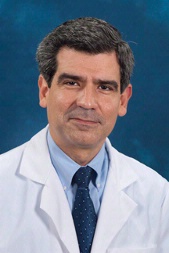URMC Receives Patent for Implantable Diagnostic Technology
URMC Receives Patent for Implantable Diagnostic Technology
November 10, 2011
The University of Rochester Medical Center (URMC) has received a U.S. patent for a medical device technology that could revolutionize the way that physician’s monitor the health of their patients. The device – which consists of an implantable “living chip” – is designed to give doctors real time information on their patients’ health and, more importantly, alert them to a change in their condition.

The URMC technology consists of a chip that holds the potential to identify – faster and more accurately – physiologic and chemical changes in the body. This personalized-medicine technology uses live cells, which are engineered to live in and function as part of the miniature electronic chip. A wireless biosensor is placed with in and around blood vessels and nerves to monitor surrounding tissues or organ systems and detect changes, which then triggers a message to a wireless device to alert the patient – or their physician – early on about a problem.
The potential application of the technology is extensive. The bio-chip could be used in patients with heart failure to detect changes in blood protein levels at an early stage, prompting the physician to alter medications to correct the problem. Currently, the patient or physician would not suspect a problem until the patient began having symptoms or underwent pre-scheduled testing at a routine visit. Catching the problem earlier means the patient remains healthier and diminishes the chance of hospitalization.
The device could also be used by researchers to monitor the effectiveness and safety of experimental drugs or to command other implanted devices – such as a wireless defibrillator/pacemaker or insulin pumps – by identifying abnormalities and prompting corrective action.
“This technology has the potential to make dramatic changes to how we practice medicine,” said Spencer Rosero, M.D., the URMC cardiologist who developed the technology behind the device. In 2005, Rosero founded Physiologic Communications and the company currently holds the URMC license for the technology.
Physiologic Communications is in the process of being acquired by Raland Therapeutics, a Perinton-based firm that focuses on interventional medicine and therapeutic devices. Raland Therapeutics – which is part of Maryland-based Raland Technologies – and Physiologic Communications have recently signed a letter of intent for merger.
“This technology is very exciting and the implications are huge,” said Bill Rader, President and CEO of Raland Therapeutics, Inc. “There are a broad range of conditions that could be impacted for the better by this novel diagnostic technology and we look forward to working with Dr. Rosero to accelerate its development.”
This new momentum represents a significant turn-around for Physiologic Communications and is an illustration of the obstacles that often face early-stage medical technology companies. While Physiologic Communications received significant support from regional economic development organizations such as Excell Partners and High Tech Rochester, the company’s steady progress – which included the creation of a first-generation prototype of the device – was stalled when the economic downturn hit and funds necessary to continue development dried up.
Rosero – who had kept operating expenses low by, among other things, purchasing used equipment on eBay – decided to put the company “in hibernation mode” while maintaining core development efforts and awaiting the patent decision.
The merger and patent now provide the technology with new resources and the intellectual property protection necessary to attract investment and continue research and development with the goal of beginning to test the device in people within the next five years.
The technology will also help reduce the cost of drug development in early stage, pre-clinical evaluations of medicines allowing for better data results when used in the laboratory. This technology will be fast tracked using a 36-month goal for use in drug testing and development.
###

Spencer Z. Rosero, M.D.
University of Rochester
School of Medicine and Dentistry
601 Elmwood Ave, Box 679
Rochester, New York 14642
> Professional Bio
Spencer Rosero is an Associate Professor of Medicine and Director of the Pacemaker Clinic. He also serves as Co-Director of the Hereditary Arrhythmia Clinic of the University of Rochester which is involved in the care of families with hereditary heart rhythm disorders such as Long QT Syndrome, Brugada’s Syndrome, ARVD, and Idiopathic Ventricular Fibrillation. He joined the University of Rochester faculty in 2000 and is certified by the American Board of Internal Medicine in Internal Medicine, Cardiovascular Disease, and Clinical Cardiac Electrophysiology and Pacing.
With his colleagues, Drs.
> Patient Care Bio
Dr. Rosero is a member of the electrophysiology section, and he specializes in treatment of patients with hereditary arrhythmias such as long QT syndrome. Dr. Rosero is an expert in complete management of pacemakers, defibrillators, and resynchronization devices.
He specializes in the management of heart rhythm disorders including: Inpatient and outpatient consultations on patients with bradyarrhythmias and tachyarrhythmias, permanent pacemaker implantation, defibrillator (ICD) implantation for the prevention of sudden cardiac death, cardiac resynchronization therapy for congestive heart failure, diagnostic electrophysiologic testing, radiofrequency catheter ablation of abnormal heart rhythms.
###
* The above story is adapted from materials provided by University of Rochester Medical Center
![]() ______________________________________________________________________
______________________________________________________________________




















